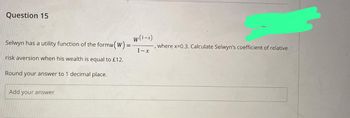
ENGR.ECONOMIC ANALYSIS
14th Edition
ISBN: 9780190931919
Author: NEWNAN
Publisher: Oxford University Press
expand_more
expand_more
format_list_bulleted
Question

Transcribed Image Text:Question 15
W(1-x)
Selwyn has a utility function of the formu (W) = - -, where x=0.3. Calculate Selwyn's coefficient of relative
1-x
risk aversion when his wealth is equal to £12.
Round your answer to 1 decimal place.
Add your answer
Expert Solution
This question has been solved!
Explore an expertly crafted, step-by-step solution for a thorough understanding of key concepts.
Step by stepSolved in 2 steps with 2 images

Knowledge Booster
Learn more about
Need a deep-dive on the concept behind this application? Look no further. Learn more about this topic, economics and related others by exploring similar questions and additional content below.Similar questions
- The value of a successful project is $420,000; the probabilities of success are 1/2 with good supervision and 1/4 without. The manager is risk neutral, not risk averse as in the text, so his expected utility equals his expected income minus his disutility of effort. He can get other jobs paying $90,000, and his disutility for exerting the extra effort for good supervision on your project is $100,000. (a) Show that inducing high effort would require the firm to offer a compensation scheme with a negative base salary; that is, if the project fails, the manager pays the firm an amount stipulated in the scheme. (b) How might a negative base salary be implemented in reality? (c) Show that if a negative base salary is not feasible, then the firm does better to settle for the low-pay, low-effort situation.arrow_forwardSuppose the Super Bowl is this week, and Raphael is in need of a television to watch the big game. As a college student, Raphael knows that he can either buy his flat-screen television at the local electronics store, or he can shop online for a better deal but have to wait four days for the television to arrive. The following problem uses the economic concept of rate of time preference to help determine which decision is better for Raphael. Throughout the question, assume that Raphael pays for the good the day he buys it, so his wealth is affected in the initial time period no matter where he buys the good. Also, assume the shipping cost and cost to travel to the store are incorporated into their respective given prices. Finally, assume the goods are identical, and there's no cost to gaining information about prices-in other words, he knows the best price online and in the store without having to search. Suppose Raphael receives a utility of 35.11 utils once he actually receives his…arrow_forwardOnly typed answerarrow_forward
- Consider the lottery that assigns a probability T of obtaining a level of consumption CH and a probability 1-T an individual facing such a lottery with utility function u(c) that has the properties that more is better (that is, a strictly positive marginal utility of consumption at all levels of c) and diminishing marginal utility of consumption, u"(c) CL. Consider du(c) for the first derivative of the utility function with respect to dc du(c) du' (c) consumption and u"(c) (which is also the derivative of the first derivative of the utility function). to be the second derivative of the utility function dc dc2 1. Provide a definition for the certainty equivalent level of consumption for the simple lottery described above.arrow_forward(a) Calculate the risk-premium on this portfolio and provide a brief interpretation of it (b) Calculate the minimum sale price of the capital assets for the average investor.arrow_forwardUse the utility function u = E (r,) – 0.5 A o, where A is the risk aversion parameter and A = 3.5. Use the average annual return on the S&P 500 as E(r,). Use the average annual interest rate on the US Government 10-year treasury bond over the past decade as r Solve for the investor's optimal allocation between the risky and the risk-free asset.arrow_forward
arrow_back_ios
arrow_forward_ios
Recommended textbooks for you

 Principles of Economics (12th Edition)EconomicsISBN:9780134078779Author:Karl E. Case, Ray C. Fair, Sharon E. OsterPublisher:PEARSON
Principles of Economics (12th Edition)EconomicsISBN:9780134078779Author:Karl E. Case, Ray C. Fair, Sharon E. OsterPublisher:PEARSON Engineering Economy (17th Edition)EconomicsISBN:9780134870069Author:William G. Sullivan, Elin M. Wicks, C. Patrick KoellingPublisher:PEARSON
Engineering Economy (17th Edition)EconomicsISBN:9780134870069Author:William G. Sullivan, Elin M. Wicks, C. Patrick KoellingPublisher:PEARSON Principles of Economics (MindTap Course List)EconomicsISBN:9781305585126Author:N. Gregory MankiwPublisher:Cengage Learning
Principles of Economics (MindTap Course List)EconomicsISBN:9781305585126Author:N. Gregory MankiwPublisher:Cengage Learning Managerial Economics: A Problem Solving ApproachEconomicsISBN:9781337106665Author:Luke M. Froeb, Brian T. McCann, Michael R. Ward, Mike ShorPublisher:Cengage Learning
Managerial Economics: A Problem Solving ApproachEconomicsISBN:9781337106665Author:Luke M. Froeb, Brian T. McCann, Michael R. Ward, Mike ShorPublisher:Cengage Learning Managerial Economics & Business Strategy (Mcgraw-...EconomicsISBN:9781259290619Author:Michael Baye, Jeff PrincePublisher:McGraw-Hill Education
Managerial Economics & Business Strategy (Mcgraw-...EconomicsISBN:9781259290619Author:Michael Baye, Jeff PrincePublisher:McGraw-Hill Education


Principles of Economics (12th Edition)
Economics
ISBN:9780134078779
Author:Karl E. Case, Ray C. Fair, Sharon E. Oster
Publisher:PEARSON

Engineering Economy (17th Edition)
Economics
ISBN:9780134870069
Author:William G. Sullivan, Elin M. Wicks, C. Patrick Koelling
Publisher:PEARSON

Principles of Economics (MindTap Course List)
Economics
ISBN:9781305585126
Author:N. Gregory Mankiw
Publisher:Cengage Learning

Managerial Economics: A Problem Solving Approach
Economics
ISBN:9781337106665
Author:Luke M. Froeb, Brian T. McCann, Michael R. Ward, Mike Shor
Publisher:Cengage Learning

Managerial Economics & Business Strategy (Mcgraw-...
Economics
ISBN:9781259290619
Author:Michael Baye, Jeff Prince
Publisher:McGraw-Hill Education